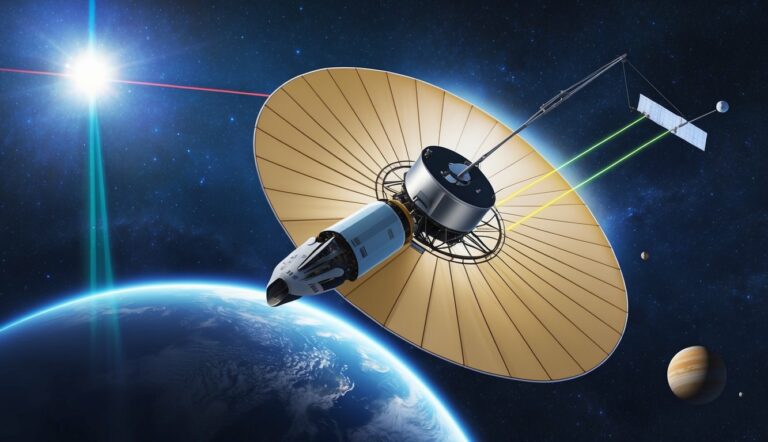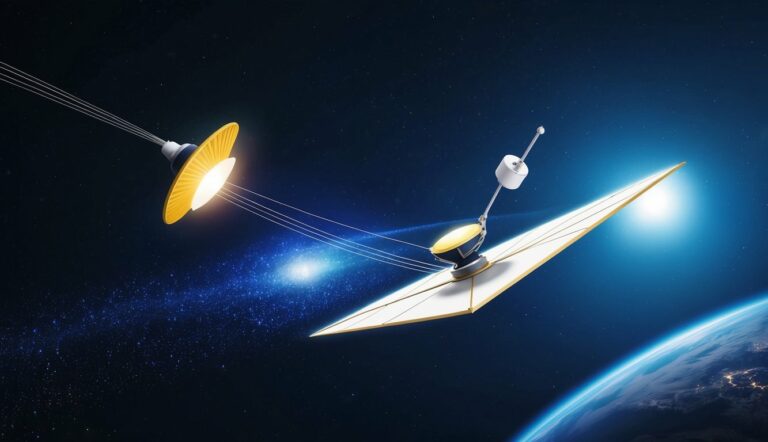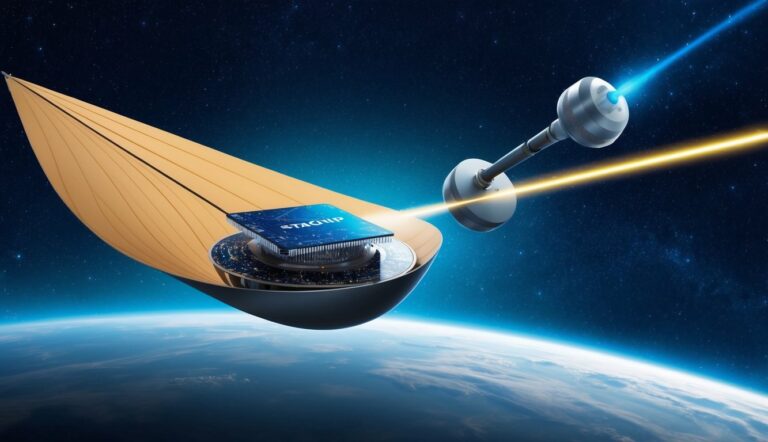Imagine being able to explore the stars beyond our solar system. That’s what the 2069 Alpha Centauri mission is aiming to do. This exciting initiative plans to send tiny spacecraft, known as StarChips, on a journey to Alpha Centauri, our closest star system, which is about 4.37 light-years away. The mission could allow us to reach the star system in just a little over 20 years.

These StarChips are not your ordinary spacecraft. They’re a part of a new class of ultra-fast, light-driven nanocrafts. The idea is to propel them using powerful lasers in hopes of achieving incredible speeds. Along the way, this project could also offer important advancements in astronomy and open up possibilities for solar system exploration.
The essence of this mission pushes the limits of what we thought possible in space travel. By striving to reach Alpha Centauri within the next generation, Breakthrough Starshot embodies the adventurous spirit of exploration and discovery that fascinates us all. Dive into the details, and you’ll find much to inspire and excite.
Background of Breakthrough Starshot

Breakthrough Starshot is an ambitious project aimed at sending tiny spacecraft to Alpha Centauri, our closest star system. This mission is driven by innovative technology and pioneering efforts from its founders.
Origins and Founders
The Breakthrough Starshot initiative was launched in 2016 by Yuri Milner, a Russian billionaire, and physicist. Together with Stephen Hawking and Mark Zuckerberg, Milner introduced this vision to the world. The idea was to explore interstellar travel through lightweight, light sail-powered spacecraft called StarChips. These nanocrafts are propelled by powerful laser beams, allowing them to travel at a significant fraction of the speed of light. This project represents a significant private investment in space exploration, with Milner committing $100 million to its development. The initiative promises to advance technology and understanding of space. You can read more about the founders here.
Scientific Objectives
The mission aims to provide a proof-of-concept for sending probes to other star systems, specifically Alpha Centauri, which is 4.34 light-years away. The goal is to develop ultra-fast, light-driven nanocrafts that can capture images and gather data during a brief flyby. These spacecraft would send back valuable information about the star system’s characteristics and check for potential planets that might support life. Additionally, the project seeks to contribute to astronomy and the study of our solar system. This exciting venture could revolutionize our understanding of distant worlds and the potential for exploration beyond our solar neighborhood. Discover more about these objectives here.
The Technology of Starshot

Breakthrough Starshot aims to send tiny spacecraft to our nearest star system, Alpha Centauri. For this mission to succeed, it relies on innovative technology including light-driven nanocrafts, a powerful laser array, and significant energy resources. Each element plays a crucial role in making the ambitious goal a reality.
Nanocraft Design
The heart of the mission is the nanocraft, a tiny spacecraft that consists of a lightweight sail and a microchip-sized probe. These nanocrafts are designed for speed and efficiency. They’re engineered to be light enough to accelerate to up to 20% the speed of light.
At the core of each nanocraft is the Starchip, a tiny, on-board computer that carries vital instruments. Despite its small size, the Starchip can perform functions like communication, navigation, and data collection from its distant target, Alpha Centauri.
The sail, made from an ultra-thin, highly reflective material, is essential for capturing the laser beam needed for propulsion. This design allows the nanocraft to travel quickly through space.
Light Beamer
The light beamer is a powerful laser array located on Earth. This system is tasked with propelling each nanocraft into space using concentrated light beams. With the help of advanced optics, these beams deliver the necessary kinetic energy to the spacecraft.
Laser propulsion is a major advancement in space travel. It allows for unprecedented speeds without the need for traditional fuel. The light beamer needs to be powerful and precise to maintain momentum over vast distances.
Challenges in this technology include avoiding atmospheric distortion and ensuring that the laser beam remains accurately targeted at each nanocraft as it speeds away from Earth.
Energy Requirements
Powering the light beamer requires a large amount of energy. The lasers used in the mission need to be strong enough to propel nanocrafts rapidly outward, a task requiring significant power resources. High-energy lasers powered by solar or other sustainable energy sources can meet these demands.
The energy demands are immense, necessitating innovations in energy production and storage. Efforts are underway to develop systems capable of efficiently supporting the project, ensuring reliable and continuous operation of the light beamer system.
Addressing energy needs is crucial for sustaining the project’s long-term goals of exploring Alpha Centauri and potentially beyond.
Alpha Centauri System

The Alpha Centauri system, closest to our solar system, consists of multiple stars and the potential for habitable zones. It offers unique opportunities for exploring nearby stars and planets, especially the chances of finding life-supporting environments.
Stellar Components
The Alpha Centauri system has three main stars. Alpha Centauri A and B are a binary pair, meaning they orbit each other closely. They are much like our Sun, which makes them interesting when thinking about life possibilities. The third star, Proxima Centauri, is a red dwarf. It’s smaller and cooler compared to the other two. Despite its size, Proxima Centauri is fascinating because it’s the nearest star to Earth, just over 4 light-years away. Proxima Centauri and its role are crucial in understanding the system’s dynamics and the potential for nearby exploration, especially since Proxima Centauri is part of the focus for interstellar missions.
Potential Habitable Zones
You might wonder about planets in Alpha Centauri that could support life. Proxima Centauri b is a planet that captures a lot of interest. This planet orbits Proxima Centauri at a distance where liquid water could exist. This zone is called the “habitable zone.” It’s an area where temperatures may allow for conditions like those on Earth. Scientists are eager to study these zones because they offer the possibility of discovering life beyond our planet, especially in such a nearby system. Exploring these areas might also help us learn more about planets that could harbor life.
Challenges and Solutions

The Breakthrough Starshot Alpha Centauri Mission faces various challenges. Key issues include communication delays due to vast distances, threats from the interstellar medium, and the technological hurdles of miniaturizing spacecraft components.
Communication Delay
In space, communication takes time. Alpha Centauri is over four light-years away, meaning messages from probes will take over four years to reach Earth. This delay can make real-time adjustments and responses impossible. Effective solutions include developing autonomous systems allowing probes to operate independently and adapt to challenges without waiting for Earth-based commands. Programmable algorithms can help probes adjust their paths and respond to unexpected conditions during their journey, ensuring missions continue efficiently even without immediate human intervention.
Interstellar Medium Hazards
Space is not empty; you’ll face various obstacles along the path to Alpha Centauri. The interstellar medium is full of dust and gas particles that could damage or alter the course of the small probes. Scientists must design strong, resilient materials for the nanocrafts, especially their “lightsails.” Protective measures might include compact shields or materials that can self-heal when punctured by micrometeoroids, preventing mission failures and ensuring the safe passage of the probes through these hazards.
Miniaturization Issues
Another major hurdle is miniaturizing components. Since the mission relies on small, chip-sized probes, every part must be incredibly compact yet highly functional. Engineers work on reducing the size of sensors, power sources, and communication devices while maintaining their effectiveness. Advances in microelectronics and nanotechnology are crucial here. Successful miniaturization will allow these small robots to remain lightweight and efficient, increasing the feasibility of launching and managing a whole fleet of them with minimal mass and energy requirements.
Impact on Science and Society
The Breakthrough Starshot Alpha Centauri Mission could change how you see space exploration. Imagine zipping through the stars to our neighboring star system in just 20 years! This mission might inspire new generations to look up at the night sky and dream of what’s out there.
Scientists have to solve many technical challenges to make this mission work. They’ll need to create ultra-fast, light-driven nanocrafts. These small spacecraft will pave the way for future space travel, pushing the boundaries of what we can achieve in science and engineering. This project might even lead to new inventions that you could use every day.
There’s also a chance that this mission might find planets orbiting Alpha Centauri. These discoveries might help answer age-old questions: Are we alone? What else is out there? Such findings could change your understanding of life in the universe.
For society, this mission might boost enthusiasm and funding for space science. Education programs could spring up, encouraging young people to study science, technology, engineering, and math (STEM).
Consider the potential cooperation between countries. The Breakthrough Starshot might unite nations in a shared quest for knowledge, fostering peace and collaboration across borders.
Your imagination is the only limit with so much waiting to be discovered. Getting involved in supporting such missions could bring excitement and hope as humanity reaches for the stars.



